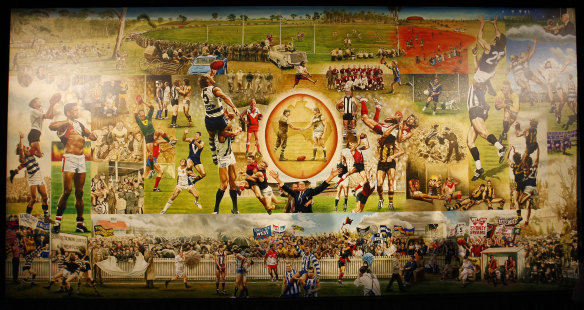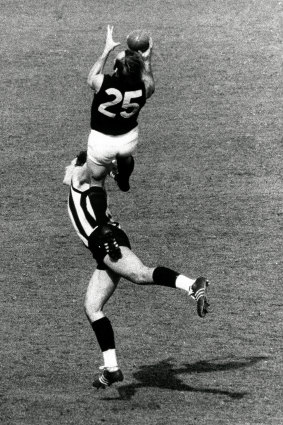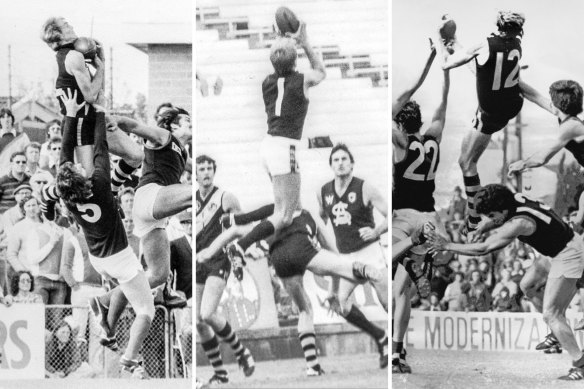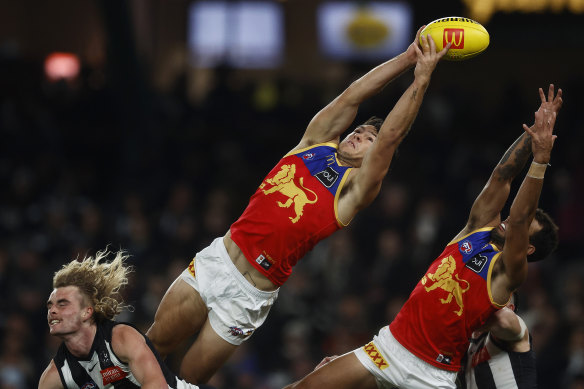Save articles for later
Add articles to your saved list and come back to them any time.
Walk into the foyer at AFL House in Docklands and you will see Australian football as it was, captured by the brush of Jamie Cooper.
There is Alex Jesaulenko rising to the heavens with that “You beauty” mark in the 1970 grand final at the MCG. There also is the image of my father, Graham, soaring as he would often do in the SANFL for his beloved club Glenelg.
Time capsule: The mural at AFL House.Credit: AFL Photos
It is now a time capsule keeping all we might lose from our great game on record.
Today, you can see those great moments on digital platforms. Before that, I would roll the VHS tapes stored in the spare room of Dad’s home.
Alex Jesaulenko’s famous mark for Carlton in the 1970 VFL grand final win over Collingwood.Credit: Dennis Bull
I would randomly select a tape like a lucky dip and quickly be mesmerised by the image of Dad with his socks pulled up, his black-and-gold guernsey tucked into his footy shorts that were two sizes too small for his skinny waist. With his long, flowing blond hair standing out, he strutted confidently.
Opposition players and fans would have seen Dad as arrogant. He was always up for a push and a shove. He gave as good as he got.
And he also brought people through the turnstiles with spectacular marks. He was an expert at it, a genuine high-flyer.
Roll the tape and you can see him coming from a mile away. The speed and timing of his run-ups would be perfect. His eyes were always solely focused on the ball. He would launch, landing one or sometimes two knees onto the shoulders of an opposition player, sometimes a teammate, and take the ball with sure hands. It was clinical brilliance.
On crashing to the ground for the landing, he rarely let go of the footy. Dad always says it looks more spectacular if you hold on to the ball.
Like so many young fans, I fell in love with the speccy.
My favourite mark from Dad’s collection is from 1980 at Glenelg Oval. He launched at the pack, this time with feet up as opposed to the usual knee lifting technique. Both his legs sat on his opponent’s shoulders. He took the grab while almost horizontal. A picture of this mark is framed on the wall in his house. I have asked it be passed to me through his will.
Graham Cornes took some spectacular grabs.
If you want to get Dad talking passionately about football, ask him about his favourite high-flyers of yesteryear – and the technicalities of the genuinely dazzling high marks.
Dad coached Adelaide full forward Tony Modra in the early 1990s. Modra’s high-flying exploits captivated the South Australian football public and made Modra the most famous footballer in Adelaide.
I was sitting behind the goals when Modra plucked the mark of the year against North Melbourne in the goal square at Football Park in 1993. I ran onto the oval after he kicked his 100th goal in the same year against Fitzroy at Princes Park. My favourite Modra mark is from round seven, 1993, against Collingwood at Victoria Park.
Today, these moments are destined to be left for artists such as Cooper and the videotapes. Concussion has cast a shadow on the game – and the sad reality is the high mark soon will be lost to the past.
In prosecuting Brayden Maynard for his attempted smother and subsequent collision that left Angus Brayshaw unconscious, it is clear that the AFL is asking players to quickly process whether their actions will risk the safety of an opponent.
The league’s legal counsel, Andrew Woods, argued at the tribunal it was not safe for Maynard to attempt to smother the ball by his forward motion and trajectory.
Bumping and tackling were once legitimate features of the game. There was no consequence if an opponent was injured.
The league lawyers will surely add smothering to the list of intolerable acts in the wake of Maynard being cleared at the tribunal.
Jakob Ryan was concussed in his first AFL game.Credit: AFL Photos
The AFL – to be consistent – will frown on players driving their knees directly into the head of vulnerable opponents, as Brisbane’s Cam Rayner did to Collingwood youngster Jakob Ryan in round 23, leaving the young Magpie concussed in his first AFL game.
It is the most dangerous legal act a player can perform on the field. The knee is a weapon.
GWS veteran Callan Ward would have missed the 2016 grand final if his team had won that thrilling preliminary final against the Western Bulldogs. He was knocked out cold when the knee of Bulldogs rival Zaine Cordy struck him in the jaw in a marking contest.
Ultimately, the AFL will argue, as it did when questioning Maynard, that a player in Cordy’s situation must spoil without raising his knees.
In round eight, Crows midfielder Matt Crouch ran back with the flight of the ball and Geelong rival Tom Atkins launched his knee into Crouch at full speed while attempting a mark. Fortunately, Atkins’ knee hit Crouch in the shoulder; a few centimetres higher and it would have hit his jaw. The injuries would have been sickening.
Should Atkins have shown a duty of care for a vulnerable player who was exposed? Could he have still contested the ball without raising his knee?
The game is being forced into change. This is not an alarmist view. The warning bells are ringing from AFL House. It started with the bump, then the tackle, now the smother and eventually, it will become knees-up in a marking contest.
The fabric of the game is slowly being eroded.
Perhaps the AFL’s new executive general manager of football Laura Kane and her colleagues at AFL House should stop to look at Cooper’s artwork at headquarters. Or I could send them those VHS tapes from Dad’s collection.
Keep up to date with the best AFL coverage in the country. Sign up for the Real Footy newsletter.
Most Viewed in Sport
From our partners
Source: Read Full Article






